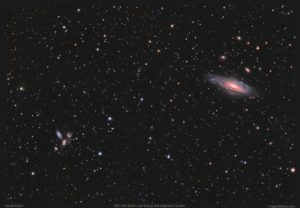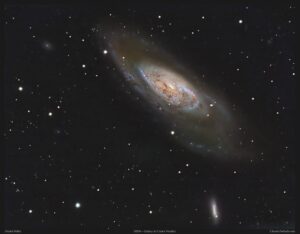A relatively un-photographed galaxy, IC 342 lies very close to the Milky Way, somewhere between 7 million and 11 million light years. The galaxy IC 342 lies in a dusty area near the galactic equator. Think of the galactic equator as the middle, horizontal line through the Milky Way galaxy. This is where most of the stars and dust are located. Peering through the galactic equator results in objects often being obscured. However, IC 342 really stands out.
Our local group of galaxies includes the Milky Way, Andromeda, Large Magellanic Cloud, M33, M32 plus many more. This group moves through the universe together. IC 342 leads up the IC 342 group of galaxies. The IC 342 group is the closest group of galaxies to our local group of galaxies.
Imaging Details
- Workflow: LRGB+HA
- Red: 60*600 seconds
- Green: 60*600 seconds
- Blue: 60*600 seconds
- Hydrogen-Alpha: 30*600 seconds
- Binning: 1×1
- Total Imaging Time: 35 hours
- Imaging Dates: (11 nights)
- 9/22/2021
- 9/23/2021
- 9/24/2021
- 9/25/2021
- 9/26/2021
- 9/27/2021
- 9/28/2021
- 10/3/2021
- 10/4/2021
- 10/5/2021
- 10/16/2021
Location
From northern latitudes, IC 342 is located very high in the sky, making it an ideal target to image. Ideally, those looking to image the IC 342 should plan for the months of August through December. During that time, the galaxy appears highest from the horizon.

Achievements
This is definitely the best galaxy image I’ve captured to date. This is also the first time one of my images has received the following recognition
- NASA Astronomy Picture of the Day (APOD): February 11, 2022
- Sky and Telescope magazine: April 2022 Reader’s Gallery
Imaging Notes
Some quick tips about imaging IC 342
- Data: This is the fourth image I’ve done where I did 10 hours per filter and the results are simply amazing.
- Exposure Length: This is the second image where I was able to use 10 minutes per frame with my red, green, blue filters. Previously, I would use 5 minute exposures. Based on the histogram, 10 minutes is my limit due to light pollution.
- Luminance: I created a synthetic luminance by extracting luminance from the integrated RGB+HA image.
- Hydrogen-Alpha: I captured 5 hours of HA data, which feels ideal. The HA regions throughout the galaxy really pop if time is spent capturing through this filter.
- Focal Reducer: This is the first galaxy I imaged using my new Starizona reducer instead of my Antares reducer. The results are spectacular. All of the strange reflections I got with Antares are now gone, which means my image calibration works perfectly.







